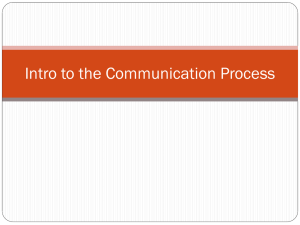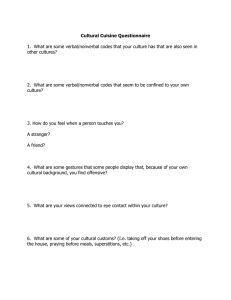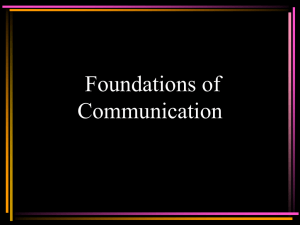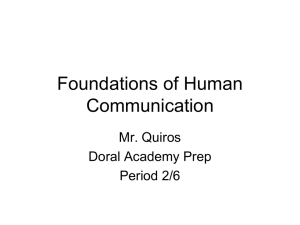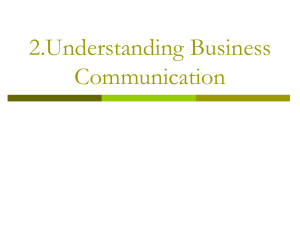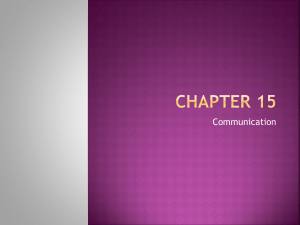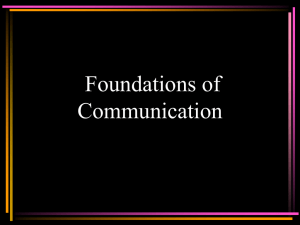Communication: The sharing of a thought, an idea or a feeling. a. involves a purposeful generation and transmission of a message by...
advertisement
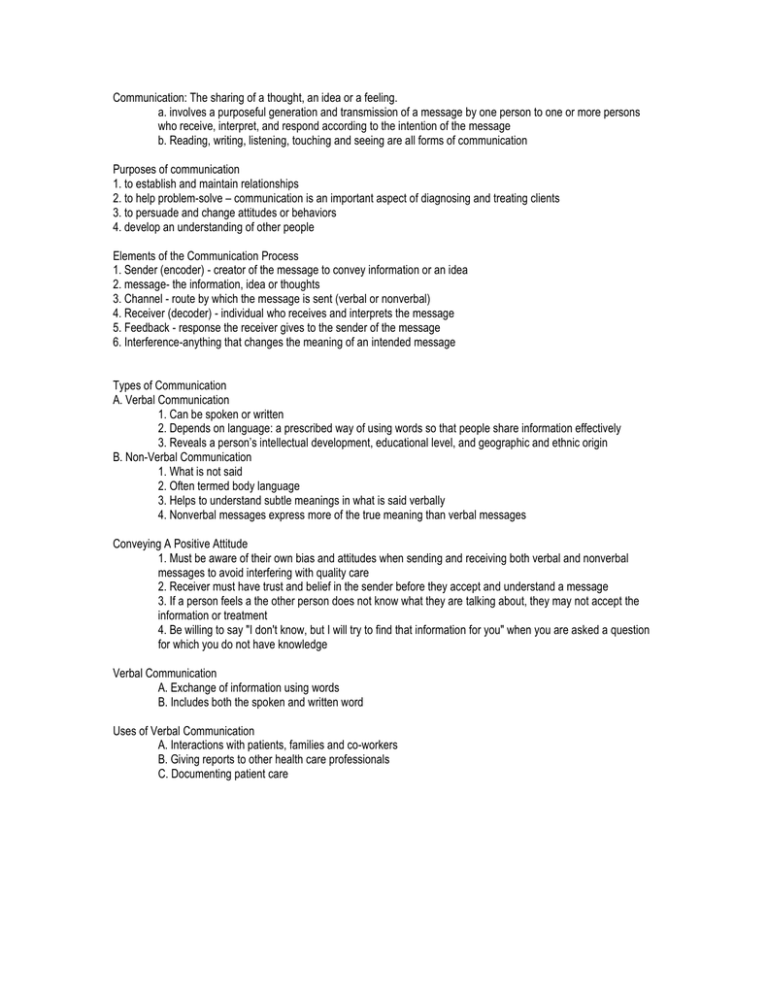
Communication: The sharing of a thought, an idea or a feeling. a. involves a purposeful generation and transmission of a message by one person to one or more persons who receive, interpret, and respond according to the intention of the message b. Reading, writing, listening, touching and seeing are all forms of communication Purposes of communication 1. to establish and maintain relationships 2. to help problem-solve – communication is an important aspect of diagnosing and treating clients 3. to persuade and change attitudes or behaviors 4. develop an understanding of other people Elements of the Communication Process 1. Sender (encoder) - creator of the message to convey information or an idea 2. message- the information, idea or thoughts 3. Channel - route by which the message is sent (verbal or nonverbal) 4. Receiver (decoder) - individual who receives and interprets the message 5. Feedback - response the receiver gives to the sender of the message 6. Interference-anything that changes the meaning of an intended message Types of Communication A. Verbal Communication 1. Can be spoken or written 2. Depends on language: a prescribed way of using words so that people share information effectively 3. Reveals a person’s intellectual development, educational level, and geographic and ethnic origin B. Non-Verbal Communication 1. What is not said 2. Often termed body language 3. Helps to understand subtle meanings in what is said verbally 4. Nonverbal messages express more of the true meaning than verbal messages Conveying A Positive Attitude 1. Must be aware of their own bias and attitudes when sending and receiving both verbal and nonverbal messages to avoid interfering with quality care 2. Receiver must have trust and belief in the sender before they accept and understand a message 3. If a person feels a the other person does not know what they are talking about, they may not accept the information or treatment 4. Be willing to say "I don't know, but I will try to find that information for you" when you are asked a question for which you do not have knowledge Verbal Communication A. Exchange of information using words B. Includes both the spoken and written word Uses of Verbal Communication A. Interactions with patients, families and co-workers B. Giving reports to other health care professionals C. Documenting patient care Elements of effective communication A. The message must be clear 1. Use terms that the receiver can understand 2. Medical terms must be modified or defined B. Deliver the message in a clear and concise manner 1. Use good grammar and correct pronunciation 2. Avoid slang terms or meaningless words such as “you know” or “all that stuff” 3. Do not speak too fast or too slow 4. Written communication should have correct grammar, spelling, and punctuation. C. The receiver must be able to hear and receive the message 1. Patients may be heavily medicated, has a hearing or vision loss, or speak a different language 2. Use alternate methods of communication such as writing the message out, using an interpreter, or repeating the message D. Interruptions or distractions must be avoided 1. Trying to talk while answering the phone or writing a message will decrease the effectiveness of communication 2. Environmental factors may affect communication, (e.g. uncomfortable temperatures or a loud TV or radio may interfere with communication.) E. Conversation (exchange of verbal communication) skills 1. Control the tone of your voice: convey interest instead of boredom, patience rather than anger 2. Be knowledgeable about the topic of conversation: be honest and confident 3. Be flexible: you may want to discuss a certain subject and the patient wants to discuss something else 4. Be clear and concise: stay on one subject at a time 5. Avoid words that might have different interpretations 6. Be truthful 7. Keep an open mind: 8. Take advantage of available opportunities Gender Bias A. Words used often reflect a gender role bias: All nurses are female. B. Gender roles have changed in the past ten years C. To eliminate bias, avoid referring to doctors as male and nurses as female -- address the person by name or title Nonverbal communication: Sending and receiving wordless messages A. Expresses more of the meaning of a message than verbal communication B. Understanding the message 1. 7% by spoken word 2. 38% by the tone of the voice 3. 55% by body language Types of nonverbal communication Gestures 1. Express variety of feelings a. contempt b. hostility c. approval d. affection 2. Can be used in addition to words 3. Differ by culture Body Language and Posture 1. unconscious barrier between you and the receiver – crossing arms 2. sign of disbelief - scratching the chin 3. good health and positive attitude – shown by erect posture 4. fatigue -slumped posture 5. angry - clenched fist 6. anxiety - clearing the throat 7. assertiveness - pointing finger 8. boredom - leaning on one's elbow with the chin in the hand 9. boredom - wiggling a foot 10. concealing something - no eye contact 11. defiant - hands on hips 12. dominance - sitting backwards on a chair 13. doubtful - touching ear 14. everything under control - thumbs in belt or pants 15. expectation - rubbing palms 16. feeling superior - hands behind one's back 17. guilt - lowering the eyes 18. honesty - open palms occasionally touching the chest 19. impatience - tapping or drumming fingers 20. insecurity - biting fingernails 21. interest in someone or something - tilted head 22. lack of confidence - failing to look someone in the eyes 23. lying - touches face 24. making a decision - stroking chin 25. needing reassurance - hand to throat 26. nervous - fiddling with items 27. readiness - standing with hands on hips 28. rejecting what is being said - rubbing nose 29. unconcerned - leg swung over chair 30. unwilling - arms crossed tightly across chest Facial Expressions 1. Most expressive part of the body 2. 7 universally accepted emotions shown a. fear b. anger c. surprise d. contempt e. disgust f. happiness g. sadness Eye Contact 1. Often initiates communication 2. Good contact means respect, a willingness to listen, and to keep communication open 3. Looking away means anxiety, defenselessness, or avoidance of communication 4. Cultural Differences a. some view eye contact as an invasion of privacy b. eye contact considered disrespectful Touch 1. Multiple meanings a. positive messages: provide affirmation, provide reassurance, share warmth, approval and emotional support b. negative messages: anger, frustration, punishment, invasion of personal space 2. Need to weigh the benefits against the negatives when using touch Communication components A. Verbal Communication – spoken or written words B. Nonverbal Communication 1. Words are not used. Instead, signals provide information 2. Nonverbal is thought to be the more honest and universal for 3. For example, a smile is seen as a positive expression in any language C. Feedback tells the sender whether the receiver got the intended message. Feedback for written communication is usually not immediate. It is critical that written communication be as clear as possible Barriers to Communication: something that gets in the way of clear communication. A. Hearing Loss 1. Use body language such as gestures or signs 2. Speak clearly in short sentences 3. Face the person you are speaking to (some people read lips) 4. Write out messages 5. Make sure that hearing aids, if used, are working properly 6. When identifying yourself, walk up to the person and get their attention before speaking 7. Don’t chew gum, cover mouth, or turn your back to the person B. Impaired Vision 1. Describe things which are happening and what you want the person to do 2. Announce your presence as you enter a room 3. Use touch to orient the person to where you are 4. Stand close to the person and in good light 5. Do not move things without telling the person 6. Tell the person when you are leaving C. Trouble Speaking 1. Ask direct questions if the person can answer yes or no 2. Allow adequate time for the person to answer 3. If you can’t understand, validate what the person is saying 4. Encourage the patient to point, nod, or write to convey a Message Levels of Communication 1. Intrapersonal Communication a. Occurs within an individual b. Also known as self-talk, inner thought c. Try to replace negative thinking with positive thinking 2. Interpersonal Communication a. One to one communication between you and another person b. Used most often in a health care situation 3. Small Group Communication a. Interaction when a small number of people meet together b. Communication is goal directed and requires an understanding of group dynamics 4. Public Communication a. Interaction with an audience b. Requires special adaptation in eye contact, gestures, voice inflection and use of presentation material Good communication and interpersonal skill enhance the quality of interactions with clients and coworkers. The rapid technological changes occurring contribute to a more impersonal atmosphere. It is important to develop and sharpen interpersonal skills. It is important to use language appropriate for the situation, evaluate the person’s ability to understand the communication, identify language barriers and select alternative methods of communication and adapt communications to accommodate individual needs. Three main barriers created by cultural diversity are language, prejudice, and attitude. People feel accepted; feel that others have an interest and concern in them when good communication skills have developed good interpersonal relationships. Communicating Effectively 1. Expressing yourself 2. Good listening skills avoid misunderstandings 3. Responding effectively 4. Assertiveness 5. Managing stress 6. Healthcare workers may experience high levels of stress. Interpersonal Relationships 1. Be warm and friendly 2. Be interested 3. Show respect 4. Be genuine 5. Be trustworthy 6. Be open-minded 7. Be empathetic 8. Discourage gossip 9. Accept criticism and learn from mistakes Relationships with employers and supervisors 1. Understand and comply with different leadership styles 2. Qualities preferred by employers a. Competence b. Cooperation c. Loyalty d. Initiative e. Trustworthiness f. Honesty g. Dependability h. Positive attitude i. Neat, clean appearance Handling Problems and Conflicts with a positive approach 1. Address the problem 2. Generate possible solutions together 3. Evaluate the possible solutions 4. Decide on a solution 5. Take action EFFECTIVE COMMUNICATION Communication is the exchange of information, thoughts, ideas, and feelings. There are times when terms must be modified, defined or substituted with other words when others convey messages. Good communication skills can lead to the development of good interpersonal relationships. A hug can convey more interest than words could ever do. Three nonverbal ways a person can convey interest and caring is by keeping eyes on the person, nodding, and smiling. All senses should be used when making observations. Correct pronunciation and the use of good grammar are essential in communication. In the communication process, tone and pitch of the voice are very important. A good way to know if the receiver is receiving the message is to have them repeat the message and show a demonstration. Listening means to pay attention to and to make an effort to hear what the other person is saying. Eye to eye contact is an important part of the communication process. When verbal and nonverbal messages agree, receiver is more likely to understand the message being sent. Nonverbal communication means to use facial expressions, body language and touch to convey messages or ideas. You need to check for understanding when a message is sent.. The receiver needs to watch closely for actions that may contradict what the person is saying. Reflective statement in the communication process is an open-ended question that the other person can respond to. There are four factors that must be met to avoid interfering with the communication process: message is clear, sender must deliver message effectively, receiver must be able to hear or receive the message, and interruptions or distractions must be kept to a minimum. Culture is a person’s beliefs, values, customs, and language. Someone not listening to you can cause you to become angry. In Healthcare: When taking care of a patient, the best observations are those that you see yourself. When documenting in a chart, it is important to remember that the chart is a legal document that can be used in the court of law. Be very careful what you write in the chart. All observations should be reported promptly and accurately. Documenting what a patient says should be in quotation marks or documented as the patient stated. Documentation must be objective and not subjective. Do not erase or use “white out” to eliminate an error or information in a legal document. Object Communication such as clothing and hairstyles 1. Healthy people with good self-esteem pay attention to dress and grooming 2. People feeling ill show much less interest in appearance and dress 3. Health Care Workers a. Uniforms clean, neat and well fitting b. If uniforms not required, clothing should be clean, neat and appropriate to the area e.g. jeans may be allowed in recreation therapy but not in a nursing area or an office
